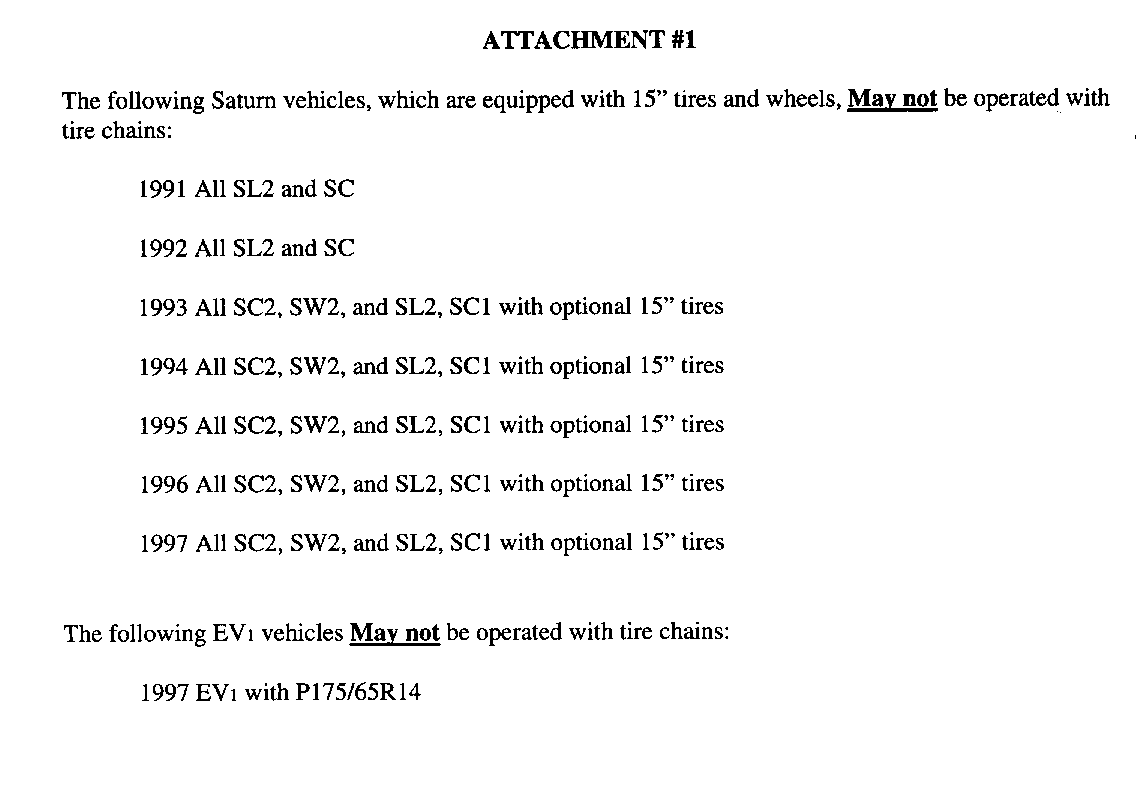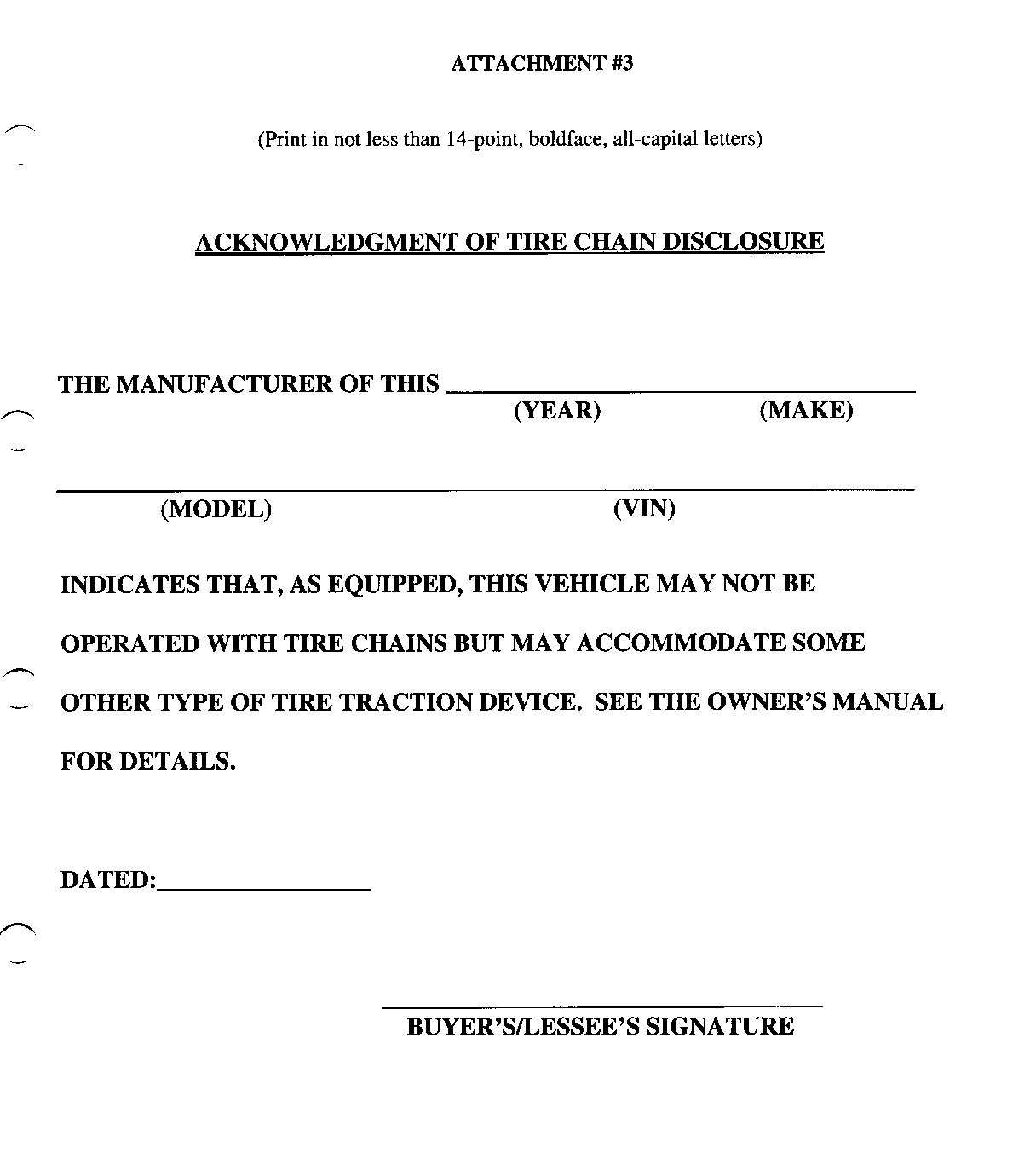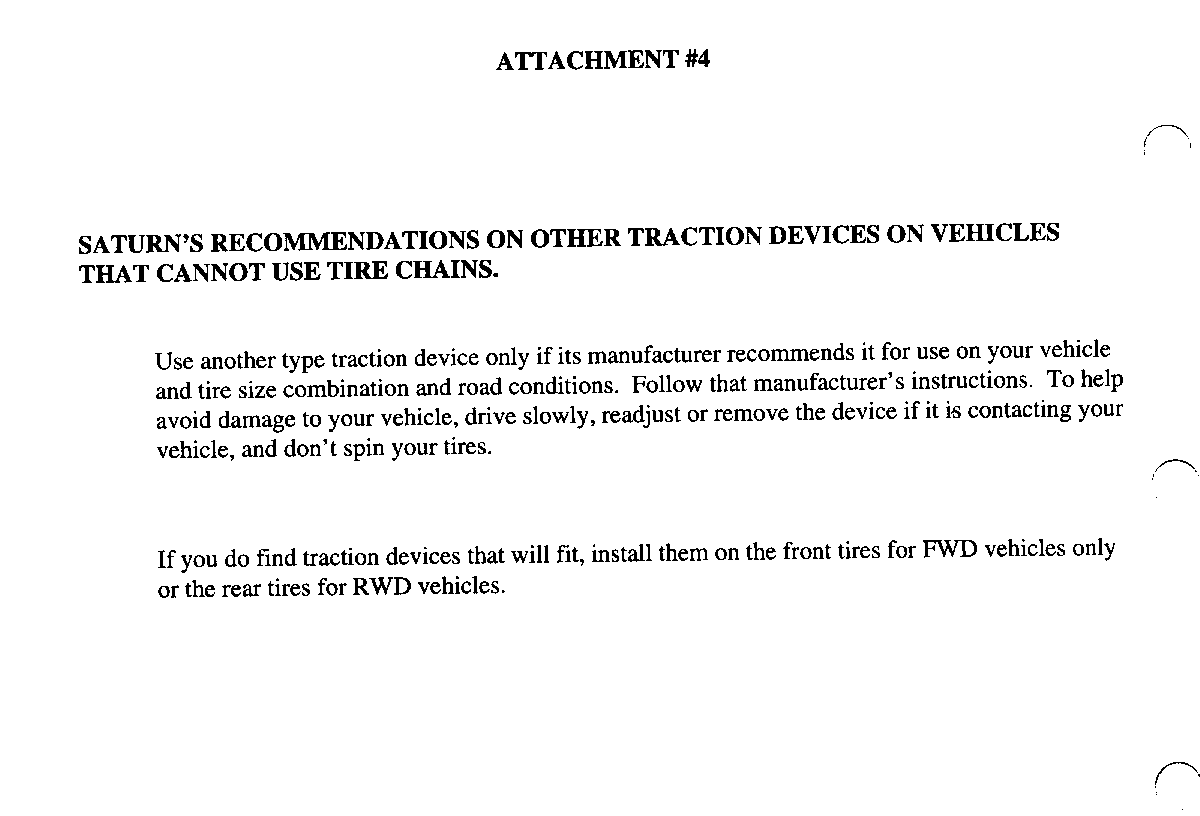CALIFORNIA VEHICLE CODE REQUIREMENTS RE:TIRE CHAIN

DATE: July 1996
SUBJECT: California Vehicle Code Requirements Regarding 1996/1997 Tire Chain Disclosure
TO: Saturn Retailers, General Managers in Califomia and Bordering States
This bulletin provides:
1. A list of 1997 models that should not be operated with tire chains (See Attachment #1);
2. The amended California law on tire chain disclosures (See Attachment #2 on Assembly Bill No. 28);
3. A revised suggested disclosure forin (See Attachment #3); and
4. Saturn's recommendation on other traction devices on vehicles that cannot use tire chains (See Attachment #4).
California Law
The California law was amended by Assembly Bill 28 and was effective on January 1, 1996. An unofficial summary of the bill includes this explanation:
... Existing law makes it unlawful for the holder of any dealer's license, as specified, to fail to disclose in writing to the buyer of a new motor vehicle, that the vehicle, as equipped, may not be operated on a highway signed for the requirement of tire chains if the owner's manual or other material provided by the manufacturer states that the vehicle, as equipped, may not be operated with tire chains.
This bill requires vehicle manufacturers to provide franchised retailers with a list of the affected vehicles, and requires the retailer to provide a specified disclosure statement to the buyer or lessee of a new vehicle, in not less than 14-point boldface type on a single piece of paper. The bill requires the retailer to furnish the buyer or lessee with a copy of the disclosure, signed by the buyer or lessee, prior to the sale or lease of the vehicle...
Section 9953 of the California Vehicle Code was amended to read:
EVERY MANUFACTURER OF A NEW MOTOR VEHICLE SOLD IN THIS STATE WHICH, AS EQUIPPED, MAY NOT BE OPERATED WITH TIRE CHAINS SHALL DO BOTH OF THE FOLLOWING:
(A) INDICATE THAT FACT IN THE OWNER'S MANUAL FOR THE VEHICLE OR OTHER WRITTEN MATERIAL PROVIDED BY THE MANUFACTURER REGARDING THE VEHICLE.
(B) PROVIDE EACH OF ITS FRANCHISED NEW MOTOR VEHICLE DEALERS IN THIS STATE WITH A LIST OF THE AFFECTED VEHICLE MODELS ON AN ANNUAL BASIS AND PRIOR TO THE MANUFACTUER IS INTRODUCTION OF ITS NEW MODEL YEAR VEHICLES. THE LIST SHALL INCLUDE SUFFICIENT INFORMATION, INCLUDING INFORMATION REGARDING TIRE SIZES WHERE NECESSARY, TO ALLOW THE SELLING DEALER TO DETERMINE WHEN DISCLOSURE IS REQUIRED PERSUANT TO SECTION 11713.6.
Section 11713.6 of the Vehicle Code was amended to read:
(A) IT IS UNLAWFUL AND A VIOLATION OF THIS CODE FOR THE HOLDER OF ANY DEALER'S LICENSE ISSUED UNDER THIS ARTICLE TO FAIL TO DISCLOSE IN WRITING TO THE BUYER OR LESSEE OF A NEW MOTOR VEHICLE, THAT THE VEHICLE, AS EQUIPPED, MAY NOT BE OPERATED ON A HIGHWAY SIGNED FOR THE REQUIREMENT OF TIRE CHAINS IF THE OWNER'S MANUAL OR OTHER MATERIAL PROVIDED BY THE MANUFACTURER STATED THAT THE VEHICLE, AS EQUIPPED, MAY NOT BE OPERATED WITH TIRE CHAINS.
(B) THE DISCLOSURE REQUIRED UNDER SUBDIVISION (A) SHALL MEET BOTH OF THE FOLLOWING REQUIREMENTS:
(1) THE DISCLOSURE SHALL BE PRINTED IN NOT LESS THAN 14-POINT BOLDFACE TYPE ON A SINGLE SHEET OF PAPER THAT CONTAINS NO INFORMATION OTHER THAN THE DISCLOSURE.
(2) THE DISCLOSURE SHALL INCLUDE THE FOLLOWING LANGUAGE IN CAPITAL LETTERS: "AS EQUIPPED, THIS VEHICLE MAY NOT BE OPERATED WITH TIRE CHAINS BUT MAY ACCOMMODATE SOME OTHER TYPE OF TIRE TRACTION DEVICE. SEE THE OWNER'S MANUAL FOR DETAILS."
(C) PRIOR TO THE SALE OR LEASE, THE DEALER SHALL PRESENT THE DISCLOSURE STATEMENT FOR THE BUYER'S OR LESSEE'S SIGNATURE AND THEN SHALL PROVIDE THE BUYER OR LESSEE WITH A COPY OF THE SIGNED DISCLOSURE.
Attachment #3 is a suggested disclosure acknowledgment form to be signed by buyers or lessees of vehicles intended for registration or primary use in California that cannot use tire chains (see attachment #1). Retailers should obtain this acknowledgment from buyers or lessees of those vehicles, retain it and give a copy to the customer.
To help you respond to questions from customers, Saturn recommendations on other traction devices on vehicles that cannot use tire chains are in Attachment #4.
Questions about the interpretation of California law should be directed to your lawyer





General Motors bulletins are intended for use by professional technicians, not a "do-it-yourselfer". They are written to inform those technicians of conditions that may occur on some vehicles, or to provide information that could assist in the proper service of a vehicle. Properly trained technicians have the equipment, tools, safety instructions and know-how to do a job properly and safely. If a condition is described, do not assume that the bulletin applies to your vehicle, or that your vehicle will have that condition. See a General Motors dealer servicing your brand of General Motors vehicle for information on whether your vehicle may benefit from the information.
